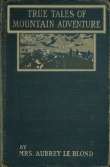You are here
قراءة كتاب True Tales of Mountain Adventures For Non-Climbers Young and Old
تنويه: تعرض هنا نبذة من اول ١٠ صفحات فقط من الكتاب الالكتروني، لقراءة الكتاب كاملا اضغط على الزر “اشتر الآن"

True Tales of Mountain Adventures For Non-Climbers Young and Old
href="@public@vhost@g@gutenberg@html@files@42758@[email protected]#illo66" class="pginternal" tag="{http://www.w3.org/1999/xhtml}a">66
ERRATA
The plate labelled to face page 225, to face page 11.
The plate labelled to face page 5, to face page 83.
TRUE TALES OF MOUNTAIN
ADVENTURE
CHAPTER I
WHAT IS MOUNTAINEERING?
Mountaineering is not merely walking up hill. It is the art of getting safely up and down a peak where there is no path, and where steps may have to be cut in the ice; it is the art of selecting the best line of ascent under conditions which vary from day to day.
Mountaineering as a science took long to perfect. It is more than a century since the first ascent of a big Alpine peak was accomplished, and the early climbers had but little idea of the dangers which they were likely to meet with. They could not tell when the snow was safe, or when it might slip away in an avalanche. They did not know where stones would be likely to fall on them, or when they were walking over one of those huge cracks in the glacier known as crevasses, and lightly bridged over with winter snow, which might break away when they trod on it. However, they soon learnt that it was safer for two or more people to be together in such places than for a man to go alone, and when crossing glaciers they used the long sticks they carried as a sort of hand-rail, a man holding on to each end, so that if one tumbled into a hole the other could pull him out. Of course this was a very clumsy way of doing things, and before long it occurred to them that a much better plan would be to use a rope, and being all tied to it about 20 feet apart, their hands were left free, and the party could go across a snow-field and venture on bridged-over crevasses in safety.
At first both guides and travellers carried long sticks called alpenstocks. If they came to a steep slope of hard snow or ice, they hacked steps up it with small axes which they carried slung on their backs. This was a very inconvenient way of going to work, as it entailed holding the alpenstock in one hand and using the axe with the other. So they thought of a better plan, and had the alpenstock made thicker and shorter, and fastened an axe-head to the top of it. This was gradually improved till it became the ice-axe, as used to-day, and as shown in many of my photographs. This ice-axe is useful for various purposes besides cutting steps. If you dig in the head while crossing a snow-slope, it acts as an anchor, and gives tremendous hold, while to allude to its functions as a tin-opener, a weapon of defence against irate bulls on Alpine pastures, or as a means for rapidly passing through a crowd at a railway


